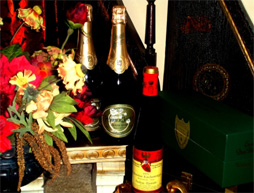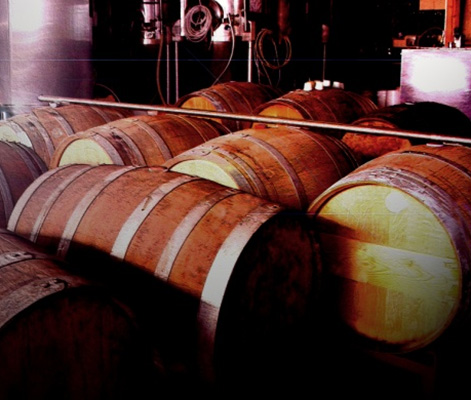Wine Aging and Beverage Enhancement
 The Company has developed a patent-pending method for obtaining desirable changes in alcoholic and non-alcoholic beverages by subjecting those beverages to flow-through advanced hydrodynamic cavitation. In the case of wine, the approach includes altering the composition and accelerating the conversion of ingredients to obtain wine with superior homogeny, an extended shelf life and a mouth feel, flavor, bouquet, color and body resembling those of wine that was subjected to traditional oak barrel maturation. Hydrodynamic cavitation-assisted wine aging can be carried out almost instantaneously: the treatment significantly improves color, palatability, mellowness and bouquet in minutes, rather than years, that is needed for a similar result through oak barrel aging.
The Company has developed a patent-pending method for obtaining desirable changes in alcoholic and non-alcoholic beverages by subjecting those beverages to flow-through advanced hydrodynamic cavitation. In the case of wine, the approach includes altering the composition and accelerating the conversion of ingredients to obtain wine with superior homogeny, an extended shelf life and a mouth feel, flavor, bouquet, color and body resembling those of wine that was subjected to traditional oak barrel maturation. Hydrodynamic cavitation-assisted wine aging can be carried out almost instantaneously: the treatment significantly improves color, palatability, mellowness and bouquet in minutes, rather than years, that is needed for a similar result through oak barrel aging.
Traditional oak barrel aging is simple, but extremely time consuming. During traditional oak barrel aging, wine ingredients react slowly with each other and the compounds extracted from the oak wood. Only low-energy reactions are feasible. Formation and/or disruption of bonds or changes in molecular structures and other chemical and physical conversions are not necessarily achieved, as these processes require more energy in order to proceed. In industrial aging, to imitate the barrel aging and enhance the extraction of vanillin, guaiacol and wood notes with fruity and varietal aromas, micro oxygenation is commonly used in combination with oak chips. The aging is affected by wine composition and the added ingredients that vary between wines and winemakers. When the wine’s peak has been achieved, the wine exhibits stable flavor and bouquet, being at its most preferred state for consumption. There are no precise criteria other than a subjective taste sensation and aroma that are both employed to determine whether the aging is complete and when the wine starts to decline. Following the peak period the process of declining or deterioration begins, resulting in a loss of qualitative wine properties. Prior to bottling, sulfur dioxide, sodium and potassium bisulfites, ascorbic acid and/or other preservatives, antioxidants and food additives are introduced in almost all of the commercial wines to prevent oxidation and preserve the wines’ flavor and color.
aging, wine ingredients react slowly with each other and the compounds extracted from the oak wood. Only low-energy reactions are feasible. Formation and/or disruption of bonds or changes in molecular structures and other chemical and physical conversions are not necessarily achieved, as these processes require more energy in order to proceed. In industrial aging, to imitate the barrel aging and enhance the extraction of vanillin, guaiacol and wood notes with fruity and varietal aromas, micro oxygenation is commonly used in combination with oak chips. The aging is affected by wine composition and the added ingredients that vary between wines and winemakers. When the wine’s peak has been achieved, the wine exhibits stable flavor and bouquet, being at its most preferred state for consumption. There are no precise criteria other than a subjective taste sensation and aroma that are both employed to determine whether the aging is complete and when the wine starts to decline. Following the peak period the process of declining or deterioration begins, resulting in a loss of qualitative wine properties. Prior to bottling, sulfur dioxide, sodium and potassium bisulfites, ascorbic acid and/or other preservatives, antioxidants and food additives are introduced in almost all of the commercial wines to prevent oxidation and preserve the wines’ flavor and color.
 In CTi’s wine aging process, optimized levels of both pressure and temperature are applied to the beverage using flow-through hydrodynamic cavitation. The process is independent of external temperature and pressure and provides a means of changing molecular composition uniformly throughout the beverage. The complete cavitation-assisted wine aging results in a smoother taste and reduced adverse after-effects. The stability of the produced compounds extends the peak period of taste and bouquet, as well as, the shelf life. The optimized usage of a flow-through hydrodynamic reactor lowers equipment, handling and energy costs, as it accelerates production of a consumable beverage. Equipment costs are drastically slashed as expensive oak barrels, prone to biological contaminations, are no longer required. Although wood may be included in the downstream processing to cause desirable changes in the taste, it is not necessary. The expedient aging and maturation negates costs related to storage and warehousing space over extended periods of time experienced with the conventional aging method. Further, flow-through hydrodynamic cavitation does not require the use of a residence container for processing as does the conventional barrel aging.
In CTi’s wine aging process, optimized levels of both pressure and temperature are applied to the beverage using flow-through hydrodynamic cavitation. The process is independent of external temperature and pressure and provides a means of changing molecular composition uniformly throughout the beverage. The complete cavitation-assisted wine aging results in a smoother taste and reduced adverse after-effects. The stability of the produced compounds extends the peak period of taste and bouquet, as well as, the shelf life. The optimized usage of a flow-through hydrodynamic reactor lowers equipment, handling and energy costs, as it accelerates production of a consumable beverage. Equipment costs are drastically slashed as expensive oak barrels, prone to biological contaminations, are no longer required. Although wood may be included in the downstream processing to cause desirable changes in the taste, it is not necessary. The expedient aging and maturation negates costs related to storage and warehousing space over extended periods of time experienced with the conventional aging method. Further, flow-through hydrodynamic cavitation does not require the use of a residence container for processing as does the conventional barrel aging.
The CTi’s breakthrough technology was used on gin that won a Double Gold Medal at the 2011 World Spirits Competition in San Francisco. The same technology produced the highest rated American vodka at the 2011 Ultimate Spirits Challenge in New York.
